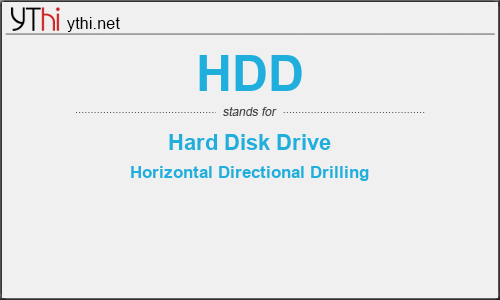What does HDD mean? What is the full form of HDD?
1, The full form of HDD is Hard Disk Drive. It’s used on Computing ,Hardware in Worldwide
A hard disk drive (sometimes abbreviated as a hard drive, HD, or HDD) is a non-volatile data storage device. It is usually installed internally in a computer, attached directly to the disk controller of the computer’s motherboard. It contains one or more platters, housed inside of an air-sealed casing. Data is written to the platters using a magnetic head, which moves rapidly over them as they spin.
A hard disk drive (HDD), hard disk, hard drive, or fixed disk is an electro-mechanical data storage device that stores and retrieves digital data using magnetic storage and one or more rigid rapidly rotating platters coated with magnetic material. The platters are paired with magnetic heads, usually arranged on a moving actuator arm, which read and write data to the platter surfaces. Data is accessed in a random-access manner, meaning that individual blocks of data can be stored and retrieved in any order. HDDs are a type of non-volatile storage, retaining stored data even when powered off.
Introduced by IBM in 1956, HDDs were the dominant secondary storage device for general-purpose computers beginning in the early 1960s. HDDs maintained this position into the modern era of servers and personal computers, though personal computing devices produced in large volume, like cell phones and tablets, rely on flash products. More than 224 companies have produced HDDs historically, though after extensive industry consolidation most units are manufactured by Seagate, Toshiba, and Western Digital. HDDs dominate the volume of storage produced (exabytes per year) for servers. Though production is growing slowly (by exabytes shipped sales revenues and unit shipments are declining because solid-state drives (SSDs) have higher data-transfer rates, higher areal storage density, better reliability, and much lower latency and access times.
2, The full form of HDD is Horizontal Directional Drilling. It’s used on Academic & Science ,Architecture & Constructions in Worldwide
Directional boring, commonly called horizontal directional drilling or HDD, is a steerable trenchless method of installing underground pipes, conduits and cables in a shallow arc along a prescribed bore path by using a surface launched drilling rig, with minimal impact on the surrounding area.
Horizontal directional drilling (HDD) is becoming widely accepted in the construction industry as a convenient way to get a pipeline drilling job done with minimum disruption to everyday life. It has gained interest mainly due to the fact that HDD projects do not involve digging up entire stretches of roads, though the entry and exit points have to be dug and cordoned off.
The rapid development of the trenchless industry can be chiefly attributed to the need for lesser environmental impact, especially when pipelines have to be laid in places that cradle plant, animal, and delicate aquatic life. (Read on in “Why the Oil and Gas Pipeline Industries are Eyeing HDD.”)
While HDD is not new in itself, its foray into the field of laying sewer, and water pipelines, and replacement or renewal of old pipelines is becoming popular only now. In fact it is still in its infancy. More contractors are now realizing the benefits of HDD. Here we will take a look at some key facts related to HDD that everyone dealing with, or planning to deal with such projects needs to know.
HDD
means
Hard Disk Drive![]()
Translate Hard Disk Drive to other language.
Horizontal Directional Drilling![]()
Translate Horizontal Directional Drilling to other language.


Leave a Reply
You must be logged in to post a comment.